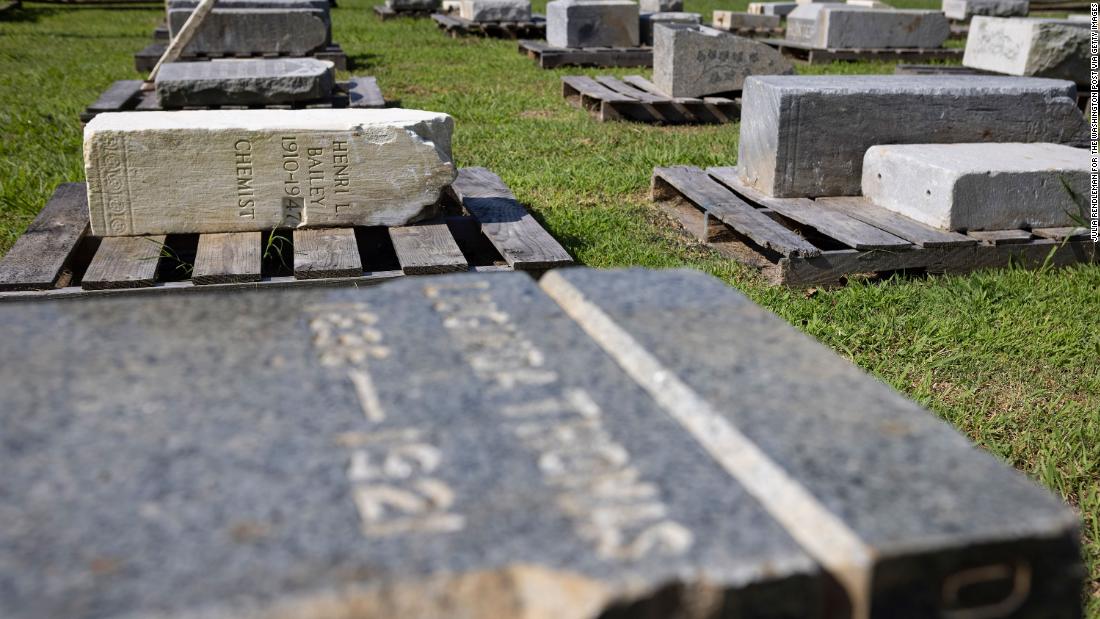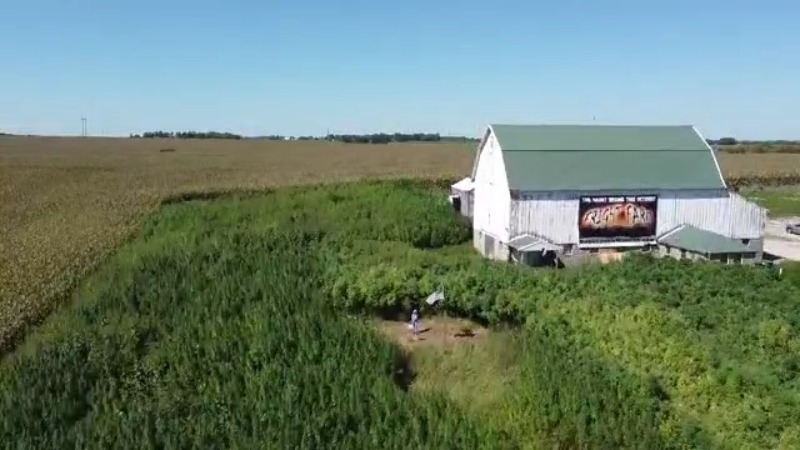On Monday, 55 gravestones that were once part of the prominent Columbian Harmony Cemetery in Washington, DC, were repatriated to a memorial park in Maryland. Virginia Gov. Ralph Northam, Maryland Gov. Larry Hogan, and Washington Mayor Muriel Bowser joined descendants of the deceased whose gravestones were discarded in returning them to a proper memorial site.
The cemetery was relocated in 1960 and the land upon which it once stood now serves as the site for the Rhode Island Avenue-Brentwood Metro station. Most remains were believed to be relocated to a memorial garden in Landover, Maryland.
However, “in a dehumanizing act, most of the grave markers and monuments were sold for scrap or dumped for erosion-control rubble along the Potomac River,” Gov. Northam’s press release states.
The headstones that were recovered from the Potomac will be transferred to National Harmony Memorial Park in Landover, Maryland, and will form part of a one-acre memorial garden to honor the 37,000 people who were laid to rest at Columbian Harmony Cemetery.
“The governor’s actions, the city’s actions to recover those headstones and put them back in their rightful place is a beautiful gesture, a kind of symbolic justice, but it should have never happened in the first place,” said Karlos Hill, an associate professor and chair of the Clara Luper Department of African and African American Studies in the College of Arts and Sciences at the University of Oklahoma.
“The families of those individuals deserve an apology, they deserve reparations for the kind of psychic trauma that this caused them and their families,” he added.
Established in 1859, the cemetery was the city’s “most prominent burial site for Americans of African descent” for almost 100 years, according to a press release from Gov. Northam’s office.
‘Black bodies still had no sanctuary,’ historian says
The desecration of the grave site was a “form of symbolic violence against the Black body,” Prof. Hill said.
Citing James Allen’s book “Without Sanctuary,” Hill said the story of the Columbian Harmony Cemetery represents the idea that “Black bodies, Black people, live in a society where they are without sanctuary. There is no safe place of refuge for Black Americans. Black people were segregated, lynched, disenfranchised from cradle to grave.”
“What this story helps us understand is that even in death, Black bodies still had no sanctuary,” Hill told CNN. “Their bodies, even in death, were not given any kind of sacred significance, so much so that their headstones were destroyed, and not just destroyed, but removed and tossed to the side as if those people never lived, as if their histories didn’t matter, their families’ memory of them didn’t matter.”
Sen. Stuart, who purchased a property along the Potomac River in 2016, discovered the gravestones one day as he was walking around the property with his wife Lisa.
“We were walking along the shoreline,” Stuart told CNN on Monday. “It was a heavily wooded area and as Lisa and I were picking our way through the woods, she just kind of looked over and then looked at me, and we realized we were looking at a headstone. And we saw another one, and we saw another one, and another one.”
Stuart said at the time that he had no idea how the headstones got there or where they came from, but he felt adamant to find out.
“I remember that day…my wife’s eyes welled up, and I felt like I had been hit in the stomach. We said we were going to do whatever we can to make this right,” Stuart said. “Nobody’s gravestone should be used as riprap on the Potomac.”
Stuart said he enlisted the help of Gov. Northam, who then called upon historians and other volunteers who eventually identified the gravestones and their origin.
Northam said in a statement Monday that the dumping of the gravestones in the Potomac after the cemetery’s relocation reflected an indignity “inflicted on people of color even after death.”
“It’s our duty to make sure these headstones are returned to the graves they were intended to mark and honor,” Northam said.
Descendant’s ‘overwhelming emotion’
Among the 37,000 people buried in the original cemetery were two sons of abolitionist Frederick Douglass, Elizabeth Keckley — a former slave and confidante of Mary Todd Lincoln, Phillip Reid — who helped create the Statue of Freedom atop the U.S. Capitol, Northam’s office said.
Another man who was buried at Columbian Harmony Cemetery was Professor William Hart, a professor of criminal law at Howard University. His descendent, also named William Hart, attended Monday’s ceremony. He said the professor was once arrested for refusing to move to a “Jim Crow car” on a train from Boston to Washington, DC in 1902, and said his ancestor fought the case and his conviction was eventually overturned.
A Washington DC native, Hart said Monday that his overwhelming emotion is that of happiness and encouragement. He thanked the crowd, including the governors and other attendants for “honoring [his] family with [their] presence.”
“I’m often asked, how do I feel, knowing that my ancestor’s remains were desecrated in such a way — and I think that the overwhelming emotion that I have every time I’m asked that question and that I continue to have in this moment– is that I am so happy and encouraged to see so many people care about this issue,” Hart said.
As a historian of lynching and racial violence, Hill says the desecration of the burial site represents the “continuum of racial violence” that can be directly connected to the 1921 Tulsa Race Massacre, when a White mob obliterated a thriving Black community in Tulsa, Oklahoma. An estimated 300 people were killed and thousands were left homeless, Black bodies were buried in mass unmarked graves.
“This is not just vandalism, it truly represents one of the most vicious manifestations of anti-Black violence,” said Hill, who added that the restoration of the gravestones might not mean that justice is served for the families that are affected.
“It wasn’t just the desecration, it was the trauma that ensued, it was their years of searching for them, coming up short,” Hill said. “There are all kinds of implications to how this played a role in the life of those individuals and the community and all of that as a part of a reparations program needs to come out.”
Elijah Anderson, a Sterling professor of Sociology and African American Studies at Yale University, draws parallels between the desecration of the burial site and the police killings of Black Americans, including Breonna Taylor and George Floyd.
“It’s heartwarming to see people trying to do the right thing, but this is against the history that we’re living out every day,” he said.
The work continues
Additional work continues to recover and restore more gravestones that once marked the lives of countless African Americans who were once buried at Columbian Harmony.
Northam said in a statement that the state of Virginia has approved $4 million for the recovery and the establishment of a Potomac shoreline memorial. Officials from Virginia, Maryland, and Washington, DC, have also partnered with the Virginia Department of Conservation and Recreation and the History, Arts, and Science Action Network (HASAN).
“This fall, crews from the National Guard in Maryland and Virginia will seek to unearth and recover additional headstones along a two-mile stretch of the Potomac near Caledon State Park, where the first ones were salvaged. HASAN has been leading efforts to work with the descendant community and research the personal stories of those buried in the cemetery,” Northam’s office said.
Additionally, a “living park-like memorial wall with protective shoreline vegetation” will be created to honor some gravestones that are illegible or are unable to be removed from the water.
“Boaters will be able to learn about the site through historic markers that will be placed at Virginia’s Caledon State Park,” a press release states.
For Stuart, the repatriation of the first 55 gravestones, five years after he and his wife first discovered them, is just “scratch[ing] the surface.”
“We’ve got a lot left to do,” Stuart said. “I would be mad as hell if my ancestors’ graves were desecrated in this way…I’m mad as hell that many of these families had to endure this…But I have been so taken by the grace that these families have shown. It’s incredibly humbling that so many people have come together to do this…so that these families can mourn their loved ones.”









